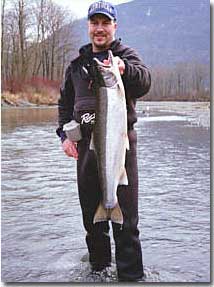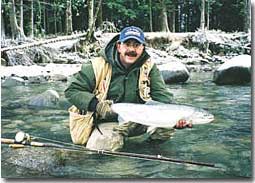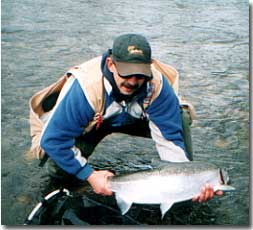Late Winter Early Spring Steelhead Tactics
Late Winter Early Spring Steelhead Tactics
By Vic Carrao
Unlike many other areas in British Columbia our local rivers like the Vedder and Chehalis have good populations of both wild and hatchery steelhead. These steelheads begin entering local rivers as early as December continuing through until late April. Local rivers will continue to produce good results well into late April for both fresh fish who have just entered and early returning fish that have been in the river for several months. Strategies used for targeting fish in December are slightly different than strategies used in March. Below we have addressed some of these differences.  During the colder months of December, January & February water temperatures are usually below 40 F. Fish tend to be more lethargic during colder temperatures, less willing to chase down a poorly presented lure or a misplaced piece of bait. Once water temperatures rise above 40 F, fish become much more active. For example if you were to stand on the edge of runs on the Vedder like the Gun Barrel, Ways Field, Ranger Run or the Train Bridge in January, the chances of seeing a fish roll would be slim to none. Stand on the same runs in March or April and you will see 10 or more rises or rolls in a day. What does this mean when fish are rolling and rising? More often than not, fish are beginning to sense the need to find a mate for spawning preparation. Steelhead like all salmon or trout will often show aggressive behavior towards other potential suitors which results in subsurface activity. Steelhead will also rise to the occasional hatch during the warmer months; they are not really feeding but react more as an instinctual reaction. I have not only seen but also heard many stories of steelhead attacking floats in the spring. If this is not a sign of aggressive behavior, I’m not sure what is. Most anglers who frequent the shores of our local rivers in search of those elusive Steelheads will come home empty handed. They say that 90% of the fish are caught by 10 % of the fishermen. This couldn’t be more accurate when talking about Steelhead. Local anglers who start the Steelhead season fishing in December and January are not only fishing for steelhead but more importantly they are reading the water, looking for regular holding locations and travel routes for later run fish. More often than not, your late season success will depend on your early season outings. Early season steelheading can be some of the more rewarding fishing you will do all season, even if you don’t hook into fish. Not only are you out fishing, which is always a good thing, but you are also gathering information that will be helpful later on in the season. Each year the rivers change, deep holes get filled in, main channels get turned into side channels, water flow rates change in various areas of the river, large tailouts get washed away, logs and debris get moved around the river channels. Last years hot spot can be totally wiped out so new water must be found. All these factors are critical to mid and late season success. During the colder months of December, January & February water temperatures are usually below 40 F. Fish tend to be more lethargic during colder temperatures, less willing to chase down a poorly presented lure or a misplaced piece of bait. Once water temperatures rise above 40 F, fish become much more active. For example if you were to stand on the edge of runs on the Vedder like the Gun Barrel, Ways Field, Ranger Run or the Train Bridge in January, the chances of seeing a fish roll would be slim to none. Stand on the same runs in March or April and you will see 10 or more rises or rolls in a day. What does this mean when fish are rolling and rising? More often than not, fish are beginning to sense the need to find a mate for spawning preparation. Steelhead like all salmon or trout will often show aggressive behavior towards other potential suitors which results in subsurface activity. Steelhead will also rise to the occasional hatch during the warmer months; they are not really feeding but react more as an instinctual reaction. I have not only seen but also heard many stories of steelhead attacking floats in the spring. If this is not a sign of aggressive behavior, I’m not sure what is. Most anglers who frequent the shores of our local rivers in search of those elusive Steelheads will come home empty handed. They say that 90% of the fish are caught by 10 % of the fishermen. This couldn’t be more accurate when talking about Steelhead. Local anglers who start the Steelhead season fishing in December and January are not only fishing for steelhead but more importantly they are reading the water, looking for regular holding locations and travel routes for later run fish. More often than not, your late season success will depend on your early season outings. Early season steelheading can be some of the more rewarding fishing you will do all season, even if you don’t hook into fish. Not only are you out fishing, which is always a good thing, but you are also gathering information that will be helpful later on in the season. Each year the rivers change, deep holes get filled in, main channels get turned into side channels, water flow rates change in various areas of the river, large tailouts get washed away, logs and debris get moved around the river channels. Last years hot spot can be totally wiped out so new water must be found. All these factors are critical to mid and late season success.
 Steelheads are creatures of habit; they sense specific areas of the river and seem to know that they once lived there. They also seem to prefer the same types of holding water and travel lanes throughout the river. If you catch a steelhead behind a specific rock, the chances of catching another one behind the same rock at a later date is very good. Same goes with larger runs and tailouts. If you hook a fish 3 feet from shore in a particular tailout the chances of hooking more steelhead there are very good. This is when your early season tactics begin to pay off. Now its mid season, there’s plenty of fish in the river and because you covered most of the river in the early season, (keeping mental notes on where fish were being hooked), you can now fish the most productive water with the least amount of guess work in primetime.
Steelheads are creatures of habit; they sense specific areas of the river and seem to know that they once lived there. They also seem to prefer the same types of holding water and travel lanes throughout the river. If you catch a steelhead behind a specific rock, the chances of catching another one behind the same rock at a later date is very good. Same goes with larger runs and tailouts. If you hook a fish 3 feet from shore in a particular tailout the chances of hooking more steelhead there are very good. This is when your early season tactics begin to pay off. Now its mid season, there’s plenty of fish in the river and because you covered most of the river in the early season, (keeping mental notes on where fish were being hooked), you can now fish the most productive water with the least amount of guess work in primetime. Most anglers who frequent the shores of our local rivers in search of those elusive Steelheads will come home empty handed. They say that 90% of the fish are caught by 10 % of the fishermen. This couldn’t be more accurate when talking about Steelhead. Local anglers who start the Steelhead season fishing in December and January are not only fishing for steelhead but more importantly they are reading the water, looking for regular holding locations and travel routes for later run fish. More often than not, your late season success will depend on your early season outings. Early season steelheading can be some of the more rewarding fishing you will do all season, even if you don’t hook into fish. Not only are you out fishing, which is always a good thing, but you are also gathering information that will be helpful later on in the season. Each year the rivers change, deep holes get filled in, main channels get turned into side channels, water flow rates change in various areas of the river, large tailouts get washed away, logs and debris get moved around the river channels. Last years hot spot can be totally wiped out so new water must be found. All these factors are critical to mid and late season success.
 Steelheads are creatures of habit; they sense specific areas of the river and seem to know that they once lived there. They also seem to prefer the same types of holding water and travel lanes throughout the river. If you catch a steelhead behind a specific rock, the chances of catching another one behind the same rock at a later date is very good. Same goes with larger runs and tailouts. If you hook a fish 3 feet from shore in a particular tailout the chances of hooking more steelhead there are very good. This is when your early season tactics begin to pay off. Now its mid season, there’s plenty of fish in the river and because you covered most of the river in the early season, (keeping mental notes on where fish were being hooked), you can now fish the most productive water with the least amount of guess work in primetime.
Steelheads are creatures of habit; they sense specific areas of the river and seem to know that they once lived there. They also seem to prefer the same types of holding water and travel lanes throughout the river. If you catch a steelhead behind a specific rock, the chances of catching another one behind the same rock at a later date is very good. Same goes with larger runs and tailouts. If you hook a fish 3 feet from shore in a particular tailout the chances of hooking more steelhead there are very good. This is when your early season tactics begin to pay off. Now its mid season, there’s plenty of fish in the river and because you covered most of the river in the early season, (keeping mental notes on where fish were being hooked), you can now fish the most productive water with the least amount of guess work in primetime. If you take a close look a most runs on the river that hold fish consistently you will begin to notice a pattern. Water flow rates are much the same, structure ranges from boulders, over hanged trees to choppy knee-deep water. The object is not as important as what it creates, safe havens for potential aggressive fish. It all sounds too easy doesn’t it? Well it really is. We all like to think that Steelhead are the smartest fish in the river. If this was true, why is it that on average each fish is repeatedly caught, often more than 3 times and even as much as 5 or 6 times with more aggressive fish. Steelhead will react in the only way they know how, head first, mouth open. It’s just a matter of time until you find that honey hole that consistently produces fish. Baits used during the warmer spring months are much the same as winter baits. The big difference is that many of the fish in the river have seen most of the lures a couple of hundred if not thousand of times so lures and baits must be more fined tuned. We like to "gear down" or "go small" if the conditions are favorable. Lighter leaders, smaller baits often out fish larger baits and heavier leaders. This is also a good time to try some of the less used lures, baits and fly's. If you prefer fishing with bait, try using small egg clusters (2 or 3 eggs), store bought shrimp (salad or larger shrimp rings) or single cured eggs. For those who prefer artificial baits, nothing beats a well-presented single Jensen egg with white wool. Spinners and Lures also work well during warmer spring fishing. Faster retrieved lures like the Gibbs Ironhead are specially designed for fast water steelhead fishing. Runs like Ways Field and larger tailouts like the Gun Barrel or Wilson Road are perfe! ct for the Gibbs Ironhead. Whether you prefer fly-fishing, drift or spin fishing, there are good angling opportunities throughout the winter and spring in the Fraser Valley. Our local resource is one that should be used but also respected. Take out what you bring in, even better, take out a little extra. For winter and spring fishing conditions, you can find weekly updated fishing reports on our website, we also offer over 15 articles archived from past issues of "The Great Outdoors" and 400 pages of useful information. Tight lines and hope to see on the water Vic Carrao
|
